PANSY’S STORY
The story of N.S.11 didn’t really needs a love interest but it got one in the shape of an extraordinary woman called Pansy Chambers, together with a fair dose of intrigue, unsolved questions and an astonishing coincidence.
Born in Holywood, Dunfriesshire, Scotland in 1898, Pansy’s parents were Major William Graham Chambers (formerly William Goulay Dunn and from a famous golfing family) and Nina Grace Chambers (the publishing family). By the time she was three, Pansy and her parents were living at Glenbrittle Lodge, Minginish on the Isle of Skye. The family travelled to Canada in 1911, living on Vancouver Island, before returning to London in 1915. Pansy had three brothers, Robert Laing Chambers (a trooper of the 1st Australian Light Horse who was killed in action at Gallipoli on 18 May 1915) and Murray Goulay Chambers, and a sister, Nina Iris Grahame Chambers.
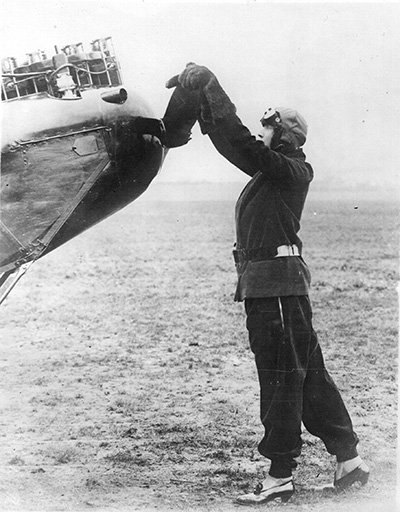
Pansy in the flying suit she designed, December 1927. Image: Deb Fitzpatrick
The next we hear about Pansy is in the 29th November 1917 edition of Flight magazine…
The engagement is announced of WALTER KEMEYS FRANCIS GOODALL WARNEFORD, Flight Commander, R.N.A.S.. son of Mr. and Mrs. Walter Warneford, of Lansdowne House, Huyton, Lancs, to PANSY GRAHAME CHAMBERS, daughter of captain W. Graham Chambers, late Gordon Highlanders, Canada, now Lieutenant-Commander, R.N., and of Ardmay, Arrocha.
Walter Warneford (Commander of N.S.11) and Pansy didn’t marry. On 15 July 1919, however, the very day NS11 was lost and Walter Warneford and his crew were killed, Pansy married Patrick Gream Nelson Ommanney at the Holy Trinity Church, Brompton, London. At the time of the marriage Patrick was a Major in the RAF, ex-Lieutenant, RN and former commander of the rigid airship R27. The airship flew 89 hours 40 minutes under Ommanney’s command, but came to a disastrous end when she was destroyed by fire together with SSZ.38 and SSZ.54 on 16th August 1918.
Patrick was son of the highly-regarded RN Rear Admiral, Sir Robert Nelson Ommanney. Sir Robert was appointed a Knight Commander of the Military Division of the Most Excellent Order of the British Empire (K.B.E.) on 1 January, 1919. All this might be significant as Patrick would certainly make a ‘better match’ for Pansy than Walter Warneford, son of a railway engineer.
Significantly, also at the church that the day of Pansy and Patrick’s wedding was Edward M. Maitland, Brigadier General of the RAF and head of the airship service who had returned from the USA to Pulham aboard R34 just two days before. His signature is written on the margin of the wedding certificate.
There can be no doubt that NS11’s commander on the night she was lost was well aware that the girl he was engaged to, announced a little more than a year and a half before, was to be married to another man that day. Whether this has any significance, or is just an incredible coincidence, will probably never be known.
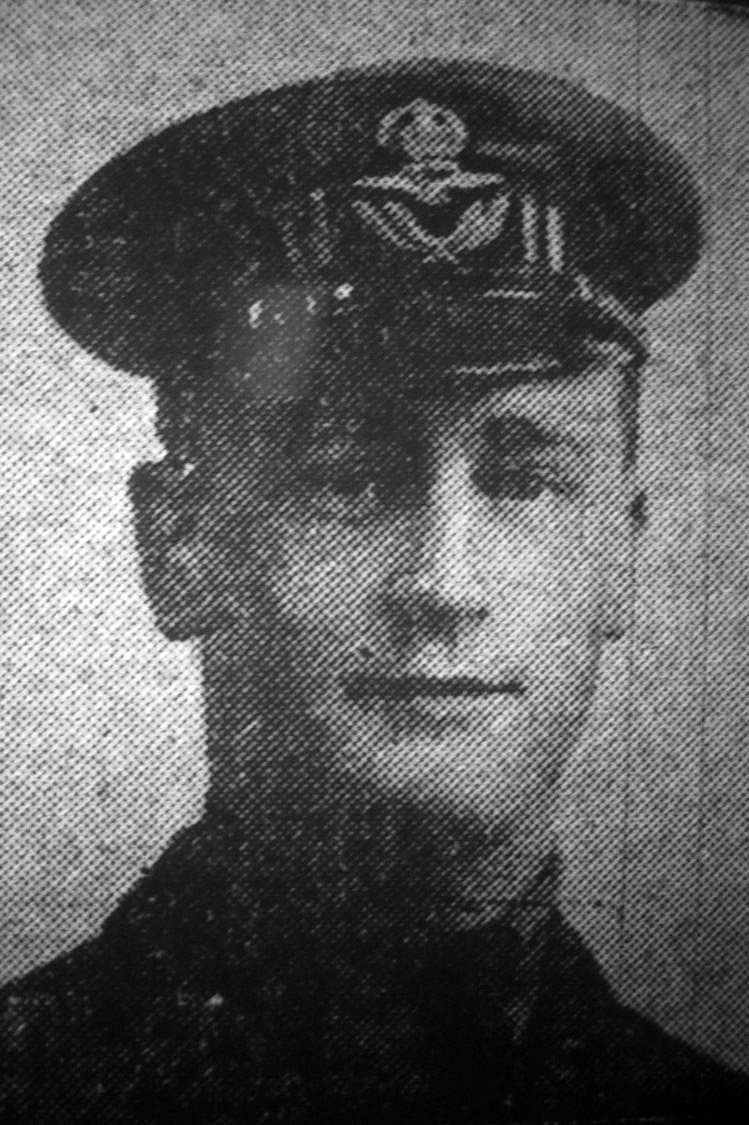
Walter K R Warneford, commander of airship N.S.11.

Certificate of marriege for Pansy Chambers to Patrick Ommanney. The wedding took place the day that N.S.11 was lost. In the margin to the right is the signature of Edward Maitland Maitland, Brigadeer General, RAF, a leading proponent of airship development and in command of all airships of the RAF. He was aboard R34 for her double crossing of the Atlantic, landing at Pulham just two days before the wedding.
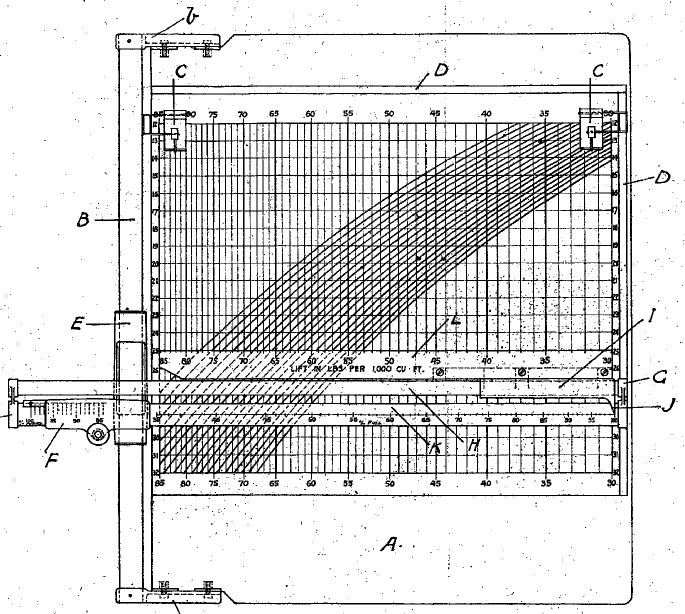
Something of an inventor, Pansy’s new husband, Patrick Ommanney is granted a patent on 5 May 1920 for an “instrument for facilitating calculations depending on the relations between the pressures, densities, temperatures and percentage compositions of gases, and the recording of observations of these quantities.” It then looks like Patrick spends most of the 1920s travelling back and forth to the USA, as first a journalist and then as a merchant (possibly for tea and coffee).
We know Pansy was an artist. She trained at St. Johns Wood Arts Academy, London and, according to her CV had work accepted at Royal Academy and Royal British Artists exhibitions.
Pansy was also a poet – probably from a young age. Her verses were published in The Tatler, Sphere, Windsor Magazine, Chambers’ Journal and London Mercury. Much in the same style as the poetry of well-known airship advocate Dame Sybil Grant, a collection of Pansy’s poetry was published in a book called Tunes On A Barrel-Organ in the 1920s. As well as poems of love and loss as might be expected, there is one poem with a strong airship theme…
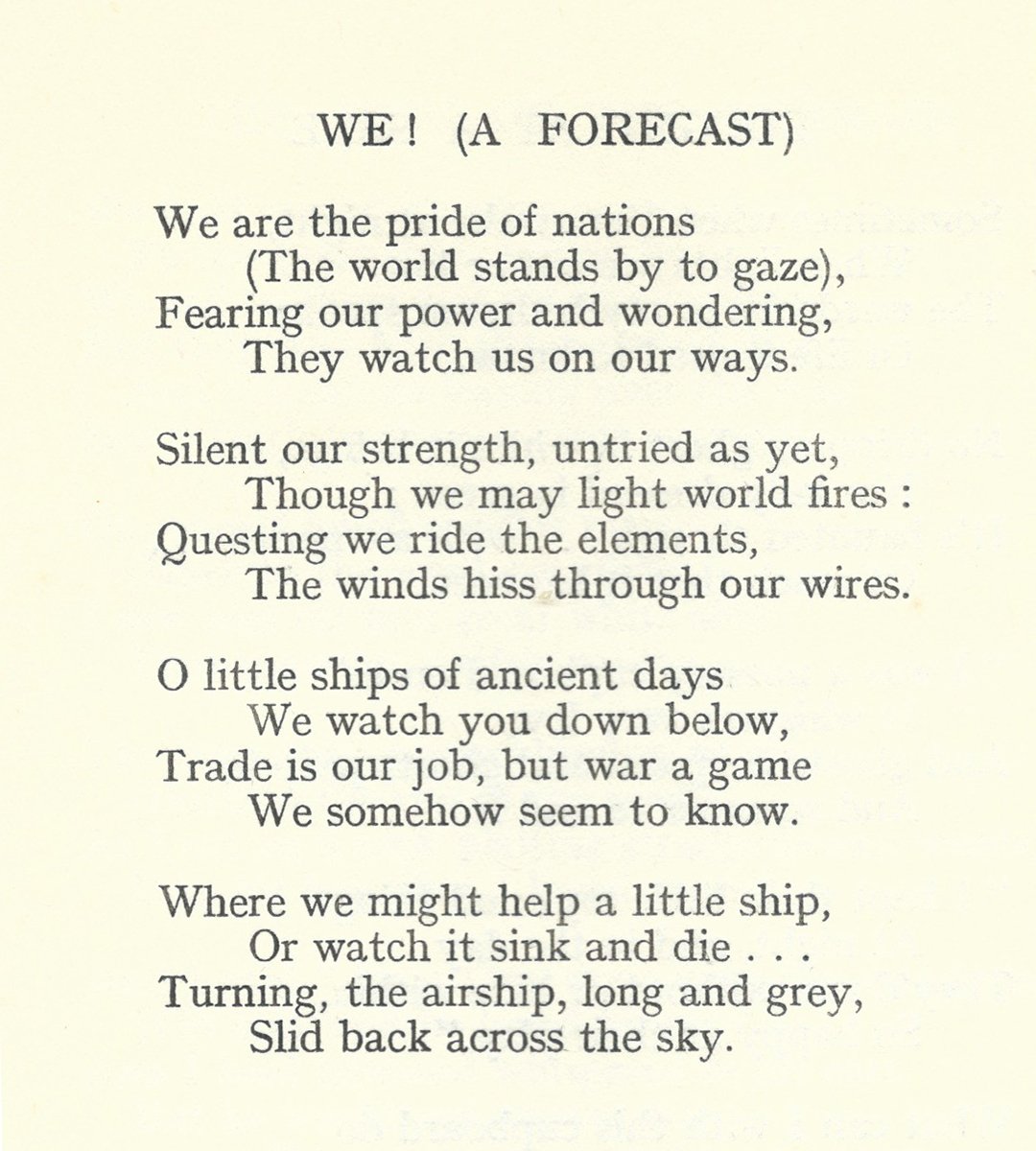
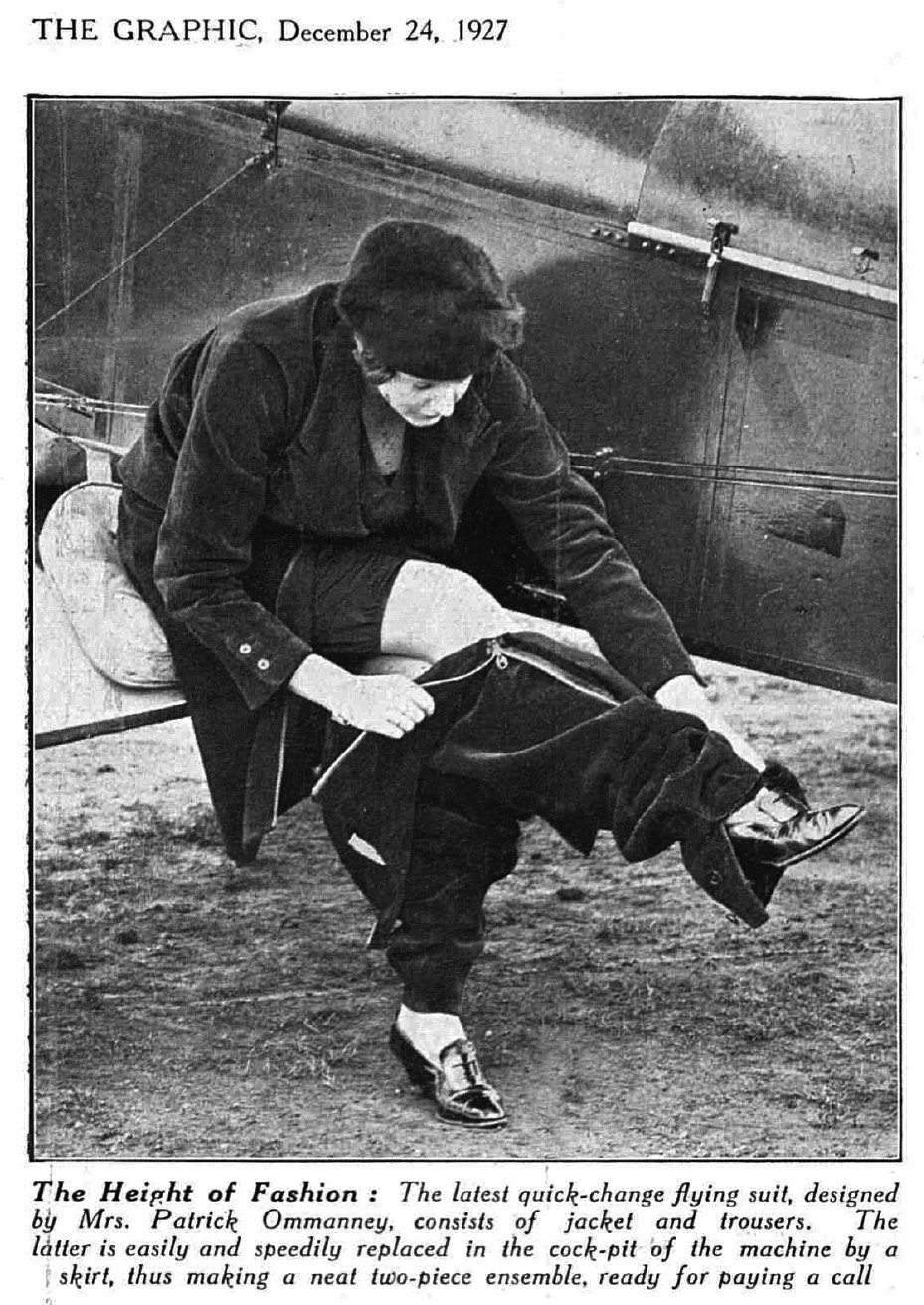
There was more to Pansy than art and poetry. She was also an aviator and fashion designer. On 24 December 1927 and interesting piece appears in The Graphic. It shows Pansy demonstrating her design of a “quick-change flying suit”. Another photo from this demonstration appears in The Sphere of 18 February 1928…
THE DESIGNER OF A VERY MODERN FROCK
Mrs Patrick Ommanney, a skilled pilot, in the costume she has designed specially for flying. This can be transformed in the cockpit of a ‘plane from a trousered creation into a luncheon frock with skirt complete.
News of Pansy and her flying suit travelled the world. On 4 February 1928 interesting appears in the Wellington Evening Post [NZ]…
A NEW FLYING FASHION
A novel quick-change flying suit, designed by Mrs. Patrick Ommanney, in a dark blue cord, which enables the wearer to perform a quick-change in the cockpit of the airplane while flying, and so be ready to take part in any social function, etc., on landing. Mrs. Ommanney is here seen in her quick-change suit, standing by her airplane ready for flight.
And in the Adelaide Advertiser of 23 January 1928…
Still They Come !
The aviation press has discovered a new heroine. This is a Mrs Pansy Ommaney a dress designer, who flies from her home in Gloucestershire, where she spends the week-ends, to London for business. She does the journey, which is 100 miles by road, just under an hour, alights at Stag lane aerodrome, and then goes on to the premises in Bond-street in time to meet the first of her clients. The disadvantage has been that she had had to arrive in her country clothes, but now she has acted as her own flying mannequin and tested a suit of black corduroys which will not show grease, and not let the cold winds through, and is not cumbersome. The trousers, fitted with patent fasteners, can be removed and exchanged in one minute for a wrapover skirt, which Mrs. Ommaney carries in pocket of her flying coat, and this transformation takes place before she alights from the machine. “She can now arrive,” said the London “Evening News,” with becoming gravity” at her office neatly dressed in a black corduroy skirt, a smart black silk jumper, a little fur cap of original design, which also folds in her pocket, and the finest silk stockings which in the air, are protected by loose-fitting trousers, buttoning to the ankle.”
While we have yet to determine if Pansy had a pilot’s licence, there is some evidence she could fly an aircraft although there is no record she owned her own aircraft. In an as yet undated newspaper clipping (but probably around 1928) we find Pansy was making her name in the world of fashion…
Mrs. Pansy Ommanney, poetess, explorer, and dress designer. As a dress designer she is making an international reputation, and her frocks are being worn by the smartest people.
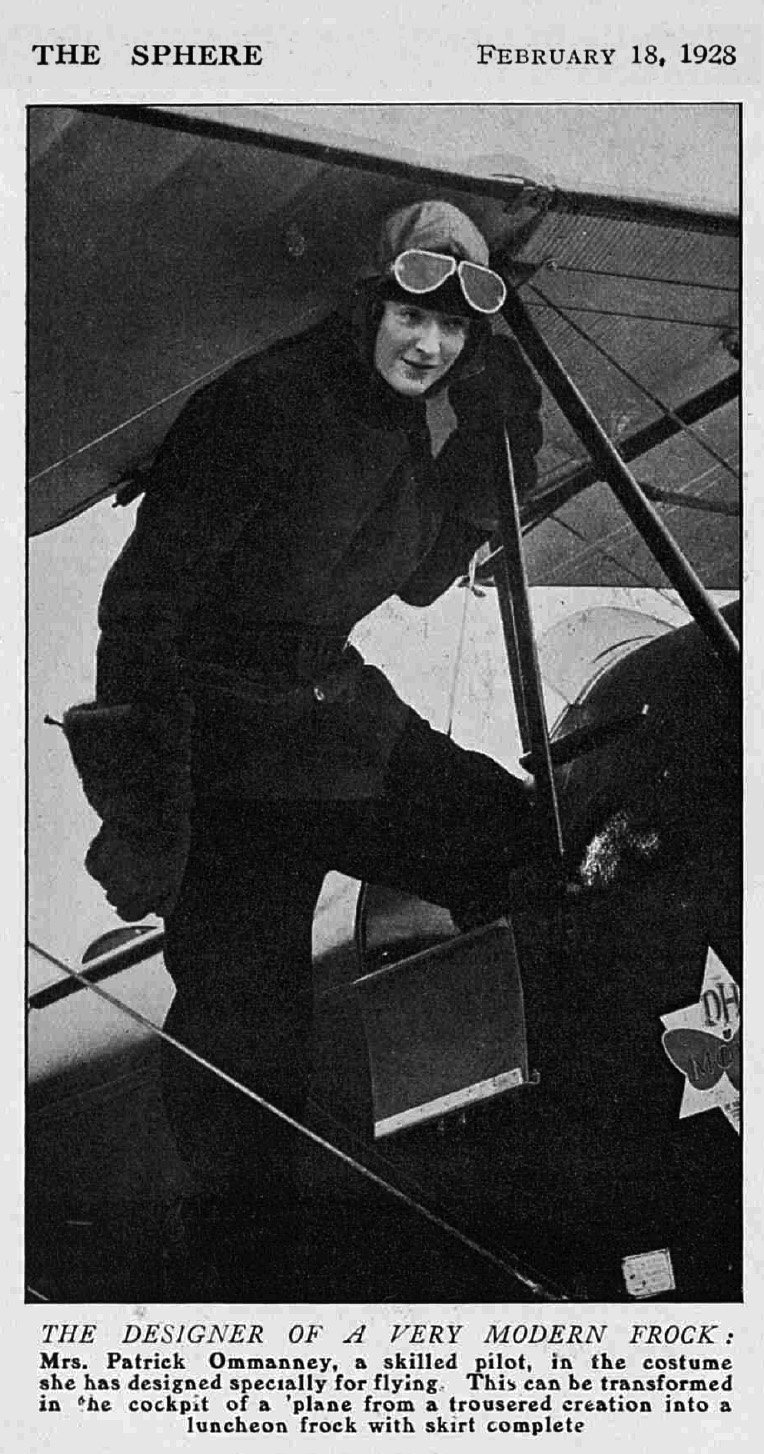
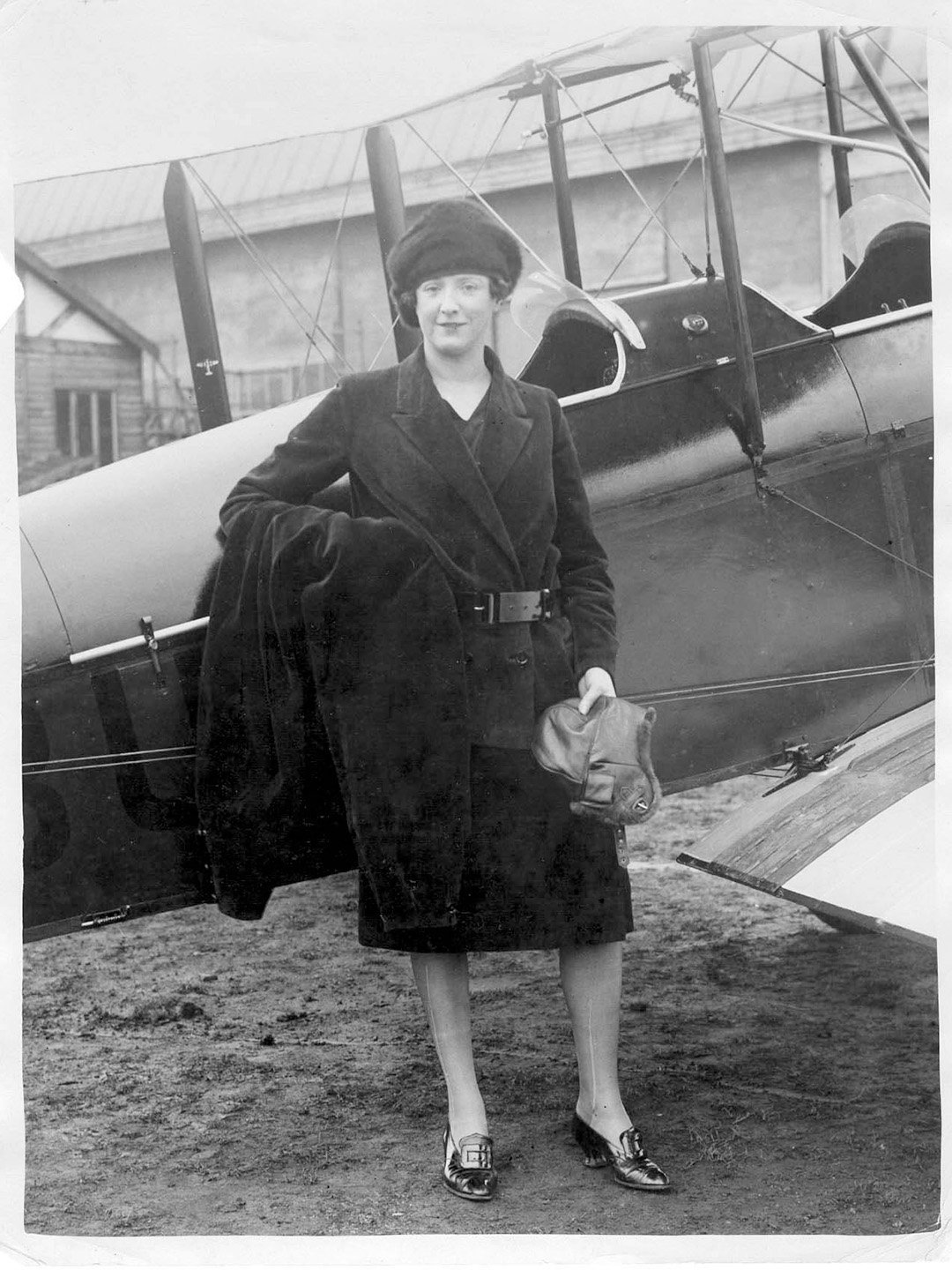
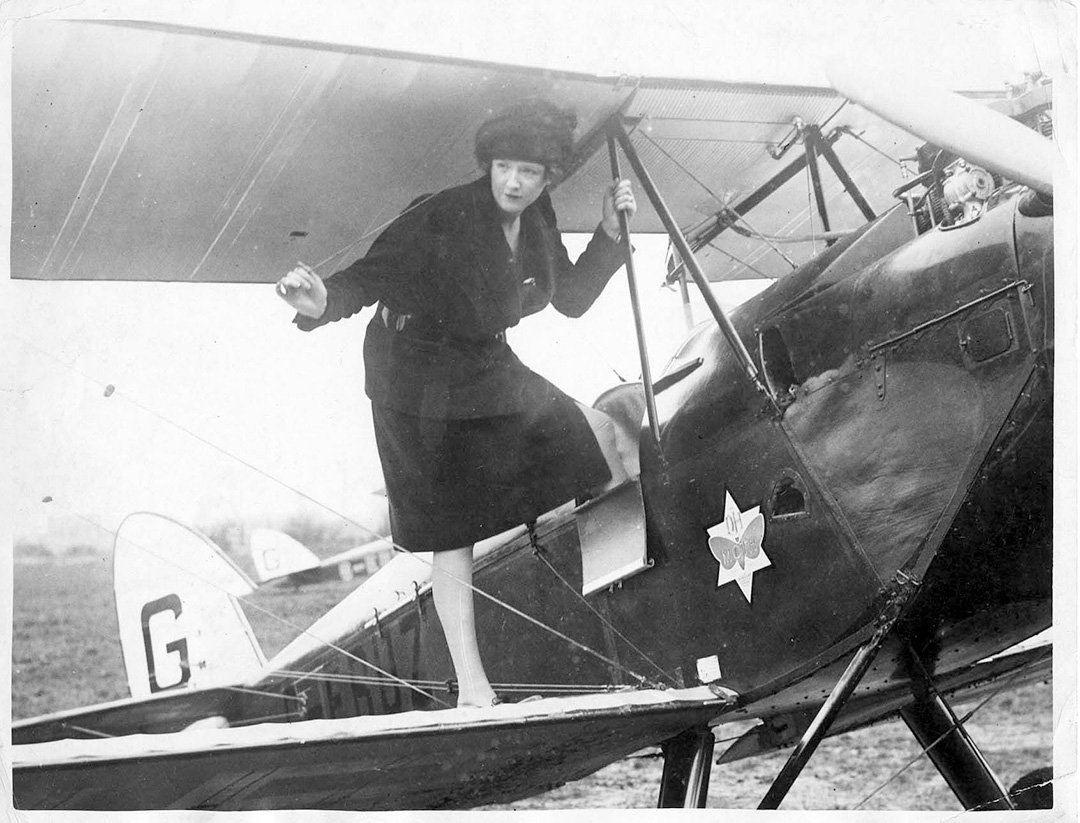
Pansy during a fashion shoot at Stag Lane Aerodrome on 13 December 1927. The aircraft is a DH.60X Cirrus Moth, registration G-EBUZ. Image: Stuart Mckay, de Havilland Moth Club
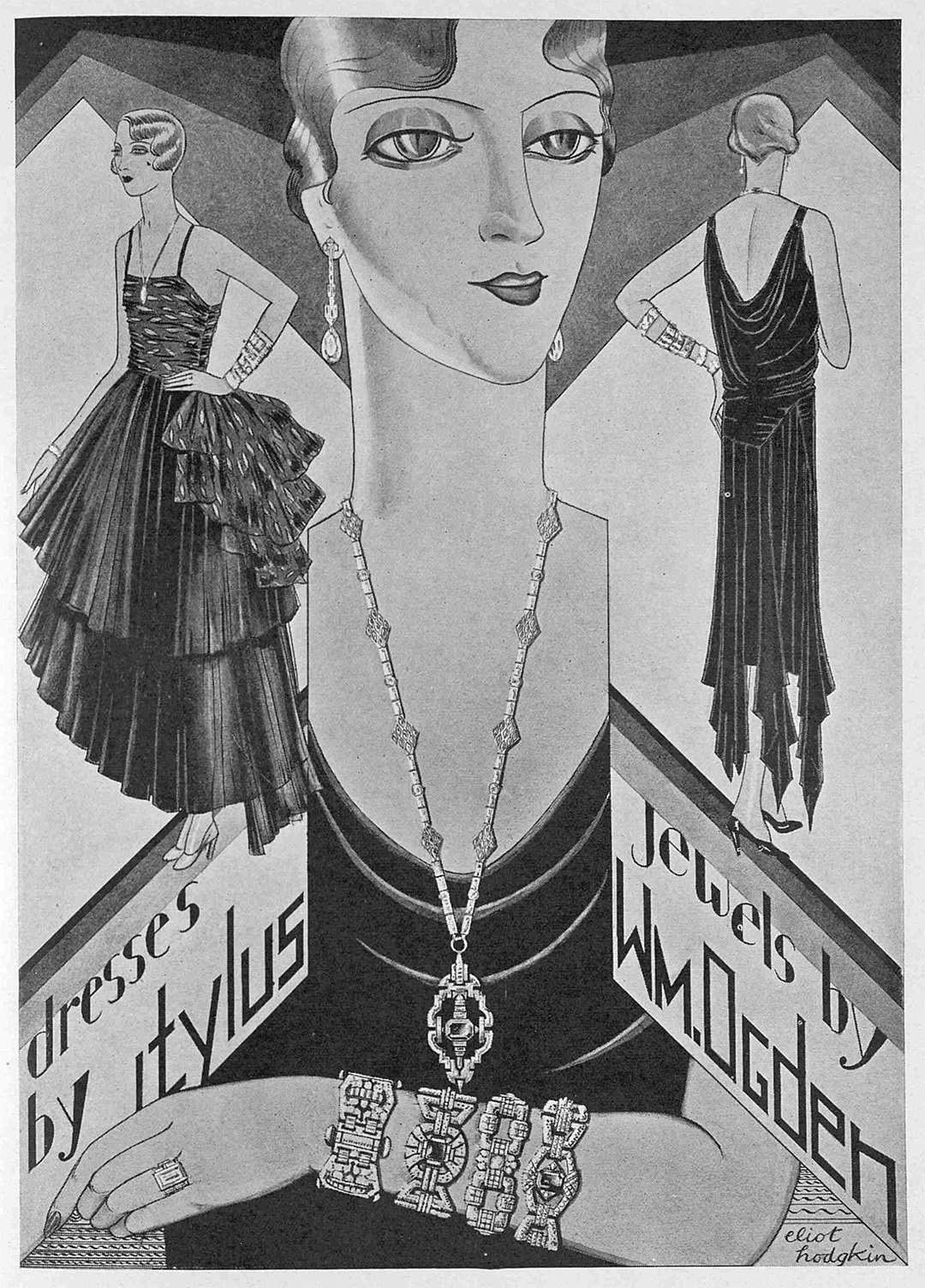
By the late 1920s Pansy had her own fashion business called House of Itylus at 149 Bond Street, London.
In 1929 Pansy and Patrick divorce.
On 12 September an announcement is made in the London Gazette…
Notice is hereby given that on the 29th day of August, 1930, PANSY NINA GRACE Chambers, of 118 Park-street, in the county of London, heretofore since the date of her marriage with Patrick Gream Nelson Ommanney, called and known by her name of Pansy Nina Grace Ommanney, renounced and abandoned the use of her said surname of Ommanney and resumed her maiden name of Chambers; and further that such change of name is evidenced by a deed dated 29th of August, 1930, duly executed by her, and attested and enrolled in the Enrolment Department of the central Office of the Royal Courts of Justice on the 8th day of September, 1930. dated the 8th day of September, 1930. GORDON DADDS and CO, 11-12, St James’-place, London, S.W.1.
At St. Giles Church, Edinburgh on 8 December 1930 Pansy married Perceval Anthony Thomas Hildebrand Harmsworth son of Sir Hildebrand Aubrey Harmsworth, a British newspaper proprietor, twice unsuccessful parliamentary candidate, and member of the Harmsworth publishing family.
In August 1939 Pansy had an article on canal cruising published in Chambers Journal. She wrote and broadcasted throughout the war and was given facilities as Air Correspondent by the Air Ministry.
Her relationship with Perceval Harmsworth was not perfect, however, as he was involved in a divorce case…
In this petition Mr. Philip Henry George Gosse[1], of Hills Road, Cambridge, sought the dissolution of his marriage with Mrs Irene Ruth Gosse on the ground of her adultery at Earl’s Terrace, Kensington, with Mr Perceval Antony Thomas Hildebrand Harmsworth, against whom the petitioner claimed damages. (£250 ordered to be paid within 14 days). The Times. 23 July 1941.
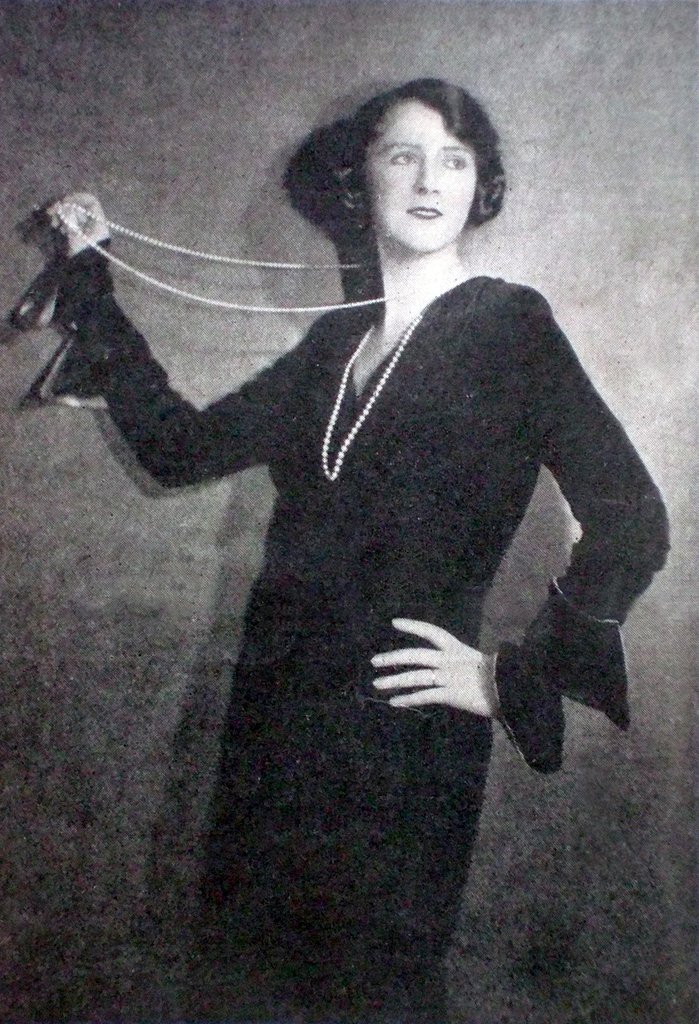
Pansy from her book of poetry Tunes on a Barrel-Organ. Image: NS11.org collection
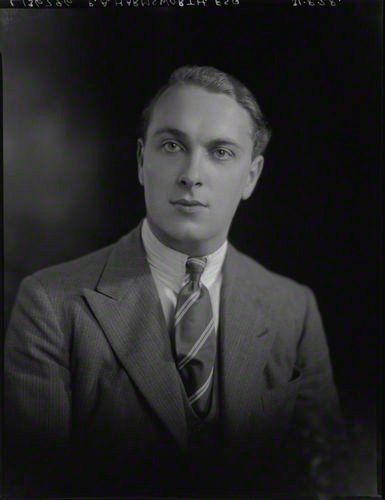
Perceval Antony Thomas Hildebrand Harmsworth. Image: National Portrait Gallery
It seems Perceval stayed with Irene. From the London Gazette of 17 July 1942…
Notice is hereby given that IRENE RUTH GOSSE of Weppons, Steyning in the county of Sussex a natural born British subject, intends after the expiration of twenty-one days from the date of publication of this notice to assume the surname of Harmsworth in lieu of and in substitution for her present surname of Gosse. Dated this 14th day of July 1942.
Pansy and Perceval did divorce.
Pansy certainly kept herself busy during WWII. What follows is from her post-war CV, so all the facts have not been confirmed…
She trained ambulance drivers in Sussex and was a member of Civil Defence. She began writing True Stories of the RAF for Chambers Journal. These stories came to attention of the Ministry of information who started reprinting them in various languages. For an On the Wing series, the Air Ministry granted facilities to visit war aerodromes and pansy completed her first radio broadcast on the Home Service on the Battle of Britain. Pansy was attached to A1.6 Air Ministry as special duties, officer without rank and broadcasted regularly on the North American Service. She also wrote a series of articles called series Canada over Here! for Canadian Forces in Britain which ran throughout war in the West Sussex Gazette and were reprinted by the Montreal Star in Canada.
When SHAEF came into being Pansy was given the rank of Squadron Officer WAAF. She did a D-Day talk on the North American Service for the RAF and well as a VE Day talk on same service. She accompanied Tactical Command RAF during Runstedt’s advance through Belgium and was “given all facilities” by the Canadian High Commissioner’s office to cover Canadian fighting forces in Britain and later by the Americans to cover for broadcast or newspapers, the 8th American Air Force. At the request of the High Commissioner for Canada’s office she monitored the film Britain sent to Canada entitled Letter from Britain made by the British Council.
Adding more background to her efforts during the war Pansy crops up in the autobiography of the jurist, Christmas Humphreys, Both Sides of the Circle…
Our friend Mrs ‘Pan’ Harmsworth, whose husband had been my pupil at the Bar, was during the war fulfilling a remarkable role in her house on the Downs near Steyning. She was indeed in the front line of England. Her house was at the same time the HQ of a Canadian Division, a depot for girls being dropped in France and returning with news, a dump for ammunition buried in the garden in case of invasion, and the off-duty home of pilots from the airfield at Tangmere. Deeply in trouble, the pilots asked for her help, and Marigold as I called this six-foot, red headed Scot, implored me when staying with her to get a message to someone very high in the RAF. Their planes just could not cope with the new German bombers coming over the coast in force. The next day I happened to go to the Garrick for lunch and sat down next to Lionel Heald, later Attorney-General. He knew Pan Harmsworth well and I murmered her trouble. “Who shall I tell” I asked. “Me,” he replied. “I am the head of Air Intelligence.” And things got done.
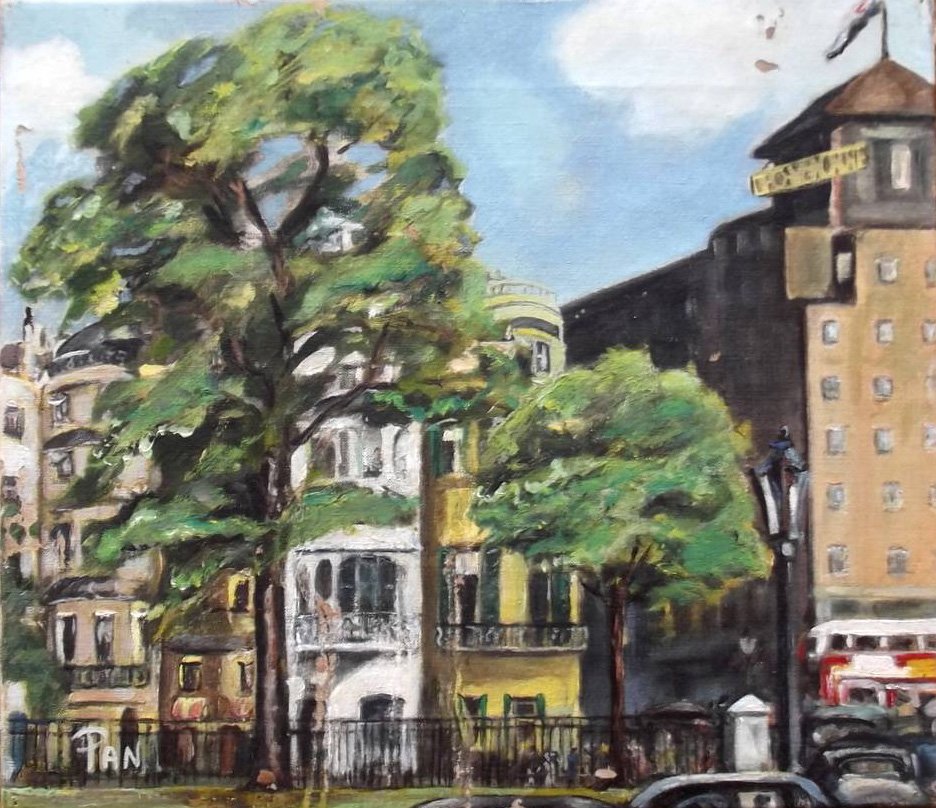
Park Lane, London by Pan Harmsworth. Image: Deb Fitzpatrick
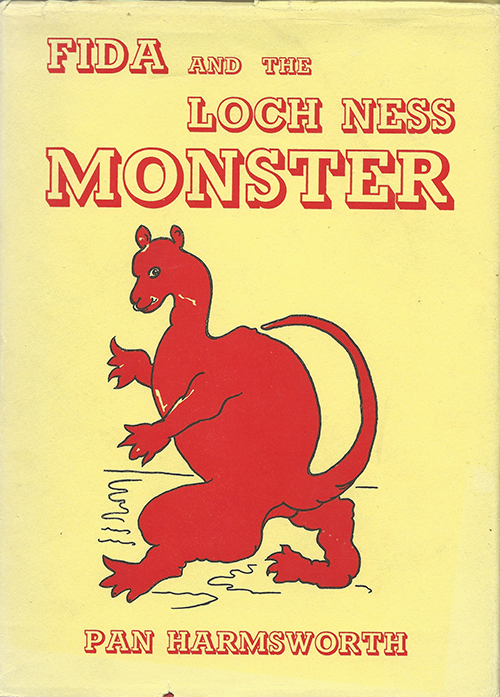
Cover of Fida and the Loch Ness Monster by Pan Harmsworth. Image: NS11.org collection
Throughout war, when she could, Pansy continued drawing painting and writing poetry. After war she gave a “one man show” at the Grafton Galleries, London which was televised by the BBC. Pansy continued to live at Kings Mead in Steyning, Sussex until late 1949, at which time she moved to Jamaica to teach art for the British Council. She left Jamaica for Le Harvre, France in 1951 and moved to Guernsey.
In 1959 Pansy married Lieut Colonel George Hornung. A son of the Africa pioneer, sugar planter, businessman and horse breeder ‘Pitt’ Horning, George was wounded during the Great War, and subsequently commanded the Horsham Battalion of the Home Guard during the Second World War.
Pansy continued to paint commissions and write. In 1964 her children’s book Fida and the Loch Ness Monster was published, followed by Fida at Violet Farm in 1965.
Pansy died in Guernsey on 17 April 1975.
Many thanks to Deb Fitzpatrick (Pansy was her great aunt), Teresa Stokes (Perceval Anthony Harmsworth’s cousin), Heather and David Henderson, Bernard Horning (George Horning was his great uncle) and David Tovey for providing invaluable detail on Pansy’s story. Thanks also to Paul Jackson for identifying the aircraft in the photographs (a DH.60 Moth owned by Christian Pittman at the London Aeroplane Club).
NOTES
1. Born in Kensington in 1879, Philip Henry G. Gosse was the son of Sir Edmund Gossse, one of the Forgotten Poets of the First World War, and the grandson of the naturalist Philip Henry Gosse. Philip studied medicine at St. Bartholomew’s Hospital in London then became a General Practitioner with a practice in Beaulieu in the New Forest. He joined the Royal Army Medical Corps in 1914 and served in WW1 on the Western Front and in India. For a time, Philip was the British Army’s Official Rat Catcher Officer on the Western Front and he toured the camps lecturing about the importance of hygiene and care of food – especially left-overs and food waste. After the War, Philip married Irene Marden in 1930 and moved to Sussex, where he wrote books and dug ponds. In 1941, he matriculated from Cambridge University and went on to work as a research student at Trinity College. He died in 1959. MORE INFORMATION